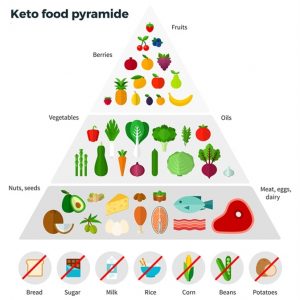As the demand for weight-loss diets rises, so do potential health risks. One of these risks is ketoacidosis, a life-threatening condition that affects people who follow low-carbohydrate diets such as the ketogenic diet. Facing ketoacidosis is an issue that many people overlook – but it’s a real hazard for dieters. In this article, we will discuss what it is, what causes it, and what steps dieters can take to reduce the risk of developing it.
Table of Contents
- 1. Exploring Ketoacidosis: What We Need to Know
- 2. Recognizing the Signs of Ketoacidosis
- 3. Managing Risk Factors for Ketoacidosis
- 4. Coping with the Challenges of Ketoacidosis
- 5. Moving Forward with Ketoacidosis Awareness
- Q&A
1. Exploring Ketoacidosis: What We Need to Know
Ketoacidosis is one of the most dangerous and life-threatening metabolic conditions that can occur when the body is unable to use carbohydrates as its primary energy source. It is important to have a basic understanding of the symptoms and treatment of ketoacidosis in order to be prepared to care for oneself or a loved one if the condition arises.
- Identifying the Symptoms: Common signs of ketoacidosis include increased thirst, frequent urination, nausea, vomiting, abdominal pain, and fatigue. It is important to note that these symptoms may overlap with other medical conditions.
- The Risks: Without treatment, ketoacidosis can rapidly worsen, which can lead to a host of other health complications including organ failure, coma, and potentially, death.
- The Treatment: If ketoacidosis is suspected, seeking medical attention is essential. The primary goals of treatment typically involve restoring the body’s chemical balance, which may involve IV fluids, insulin, and electrolytes.
Knowledge and awareness of ketoacidosis is key to living a healthy and safe life. Keeping a look out for potential warning signs and knowing when to seek medical care can help ensure that more serious health complications can be avoided.
2. Recognizing the Signs of Ketoacidosis
Ketoacidosis is a serious and potentially life-threatening medical condition. For this reason, it is crucial to recognize its signs and take the necessary measures to properly address it. These are the key indicators to look out for:
- Intense thirst
- Frequent urination
- High blood sugar
- Nausea and vomiting
- Abdominal pains
- Fruity-smelling breath
If you experience any of the above symptoms, seek medical attention right away. Ketoacidosis can affect any person at any age, particularly individuals with type 1 diabetes. Therefore, understanding these signs can help prevent further health complications. Additionally, any changes to an existing treatment plan should be discussed with a health care professional, who can provide invaluable advice on how to best manage it.
3. Managing Risk Factors for Ketoacidosis
In order to guard against ketoacidosis, it’s important to take steps to reduce or manage risk factors. Insurance providers often partner with patients to do this, offering resources and guidance. Here are some of the key strategies to address:
- Monitoring your blood glucose regularly.
- Following your medication and diet plan as prescribed.
- Avoiding excessive alcohol consumption, as excessive alcohol can affect the body’s ability to regulate blood glucose levels.
- Regularly visiting your healthcare provider to ensure that your diabetes is under control.
- Seeking medical treatment as soon as possible if symptoms of ketoacidosis occur.
It’s also important to remember that, while there are steps you can take to mitigate your risk for ketoacidosis, it’s still possible for the condition to develop even when all risk factors are addressed. So if any of the symptoms associated with ketoacidosis arise – such as a fruity odour on the breath, nausea, and/or confusion – seek medical attention immediately.
4. Coping with the Challenges of Ketoacidosis
Avoiding life-threatening complications of ketoacidosis is of paramount importance. Thankfully, with the proper treatment and management, a full recovery is expected. Below are 4 simple steps for managing and coping with the effects of ketoacidosis.
- Monitor blood sugar levels: Properly monitoring your blood sugar levels can help you stay ahead of any potential complications. This involves testing your glucose levels consistently and promptly treating any symptoms of the condition.
- Drink plenty of fluids: Staying hydrated is essential to recovery. When you’re dehydrated, your body isn’t able to get rid of the ketones as quickly as it should. Keeping your fluids up will assist your body in flushing out the ketones.
- Eat a balanced diet: A balanced, healthy diet is key for coping with ketoacidosis. This involves eating plenty of fruits, vegetables, and whole grains. Complex carbohydrates and lean proteins are also important. Avoid processed and saturated fats.
- Seek medical assistance: If you experience severe symptoms of ketoacidosis, seek medical help immediately. Constant monitoring and medication may be necessary for a successful recovery.
By following these steps, you can help yourself cope with ketoacidosis and effectively manage the condition. Your doctor can also provide further guidance on how to manage the condition. Stay vigilant and informed, and with the right care, you can easily overcome ketoacidosis.
5. Moving Forward with Ketoacidosis Awareness
The ketoacidosis awareness movement is steadily gaining momentum, with more and more people recognizing the serious health consequences associated with it. Here are five ways you can increase awareness and move forward in the fight against ketoacidosis.
- Spread the Word – Educate your friends and family about the dangers of ketoacidosis and how to identify the signs and symptoms. Share stories of your own experiences to encourage others to pay attention to their own health.
- Become Involved – Find a local support group in your area, or join an online community. Connect with others who have been affected by ketoacidosis and share stories with each other.
- Raise Funds – Raise money to support initiatives to increase awareness and support those affected by ketoacidosis. Focus on advocating for more research into early detection methods for ketoacidosis.
- Volunteer – Get involved in a number of organizations that are working to increase awareness about ketoacidosis. Offer your time and energy to help run events, be a speaker at an event, or even organize activities to spread awareness.
- Advocate – Reach out to local and national representatives and ask them to support initiatives to increase access to information and resources about ketoacidosis. Advocate for laws and policies that support those affected by ketoacidosis.
Each action brings us a step closer to a better understanding of ketoacidosis and more importantly, an improved quality of life for those living with it. By taking the initiative now and becoming proactive, we can get closer to ensuring that those affected by ketoacidosis can receive the best possible care.
Despite the potential risks, ketoacidosis is not necessarily a deal-breaker for people considering a ketogenic diet. With proper guidance and careful monitoring, most people can enjoy the benefits of a ketogenic lifestyle while avoiding the risk of ketoacidosis. With the right measures in place, you can start transforming your life today—all without worrying about ketoacidosis.











